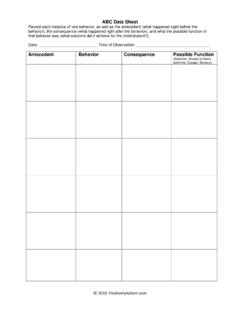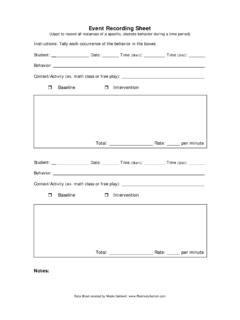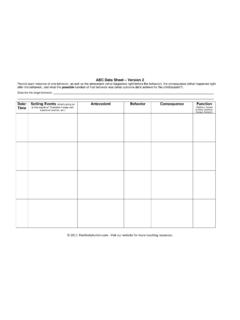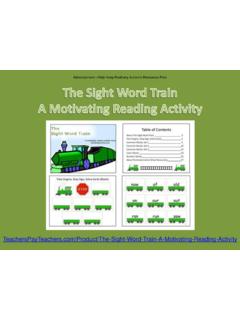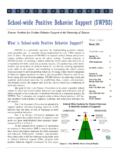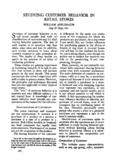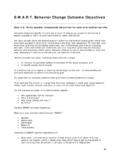Transcription of Behavior Traffic Light - Positively Autism ~ Autism ...
1 Behavior Traffic Light A system for reducing problem behaviors. A resource from : Help and Resources at Hand Online Autism Classes: Teaching Materials: Social Skill Stories: Behavior Improvement: Autism Tutorials: Free Newsletter: Table of Contents Introduction 4 Steps 5 Tips for Success 9 Traffic Light Design 1 11 Traffic Light Design 2 12 Staying on the Green Story 13 Introduction The Behavior Traffic Light is a system for addressing problem behaviors.
2 This is a level system in which a child earns privileges at different levels depending on his or her Behavior . In this system, the levels of Behavior correspond to different levels on the Traffic Light green, yellow, and red. Green is the highest level of privileges (when the child is behaving well), yellow is the next level (when the child is engaging in minor problem behaviors), and red is the level on which the child is engaging in severe problem behaviors, such as a meltdown or aggressive Behavior .
3 The child moves to different levels in the system depending on his or her Behavior throughout the day. The goal of the system is to motivate the child to control his or her own Behavior in order to earn rewards and privileges. The focus is not on punishment, but rather reinforcing the child for behaving appropriately. Please note that this plan does not substitute for professional advice from a Behavior specialist such as Board Certified Behavior Analyst (BCBA). Steps the behaviors associated with each color (whatever you decide the Behavior should be) Green might mean the child is doing what they are supposed to (following adult direction, using nice words, keeping hands to yourself, etc.)
4 Yellow Behavior might mean being somewhat disobedient or disrespectful (to the extent that the child understands those concepts). Be sure to explain this in terms the child understands. Red might mean being aggressive, blatantly and extremely disobedient, or having a fit or meltdown. what the child is allowed to have at each level Green should describe a child's normal level of freedom. Yellow should describe a significant (but not extreme) level of restriction. Red describes a higher level of restriction In the example picture (on next page), the child could have his favorite items: TV, computer, tablet computer, and chocolate milk only when he was on the green.
5 On yellow, the child could have juice, snacks, toys, and games. On red, the child was wasn t allowed to have any of those items, but could, of course, still have regular meals and water. For this child, being on the red meant that he was having a meltdown, so he didn t particularly want anything during those times anyway. Example of the Chart with Privileges Steps, Continued. 3. Decide on a check-in time. When a child is disobedient, he or she is placed on the appropriate color. They stay on that color until the check-in time.
6 You may also choose to provide one warning to allow the child the chance to get their Behavior under control before changing colors. This may help them learn to do this. The check-in time is a chance to reflect on the reason a child is on a certain color and, if necessary, move back to green. Let s say we ve chosen a check-in time of 20 minutes. We will stop every 20 minutes and talk with the child about how his or her Behavior has been during that time. If the child has stayed on green, he or she is praised.
7 If he or she has been moved to yellow or red, he or she has an opportunity to move back to green, if you deem their current Behavior appropriate. If a child is younger or has high amounts of problem Behavior , a shorter interval should be chosen. You want to make sure the child has a good chance of being successful when you start using the system, in order to motivate him to continue having success. As Behavior improves, you can increase the length of time for the check in time. 4. Teach the system to the child.
8 Explain to the child how the system works, what privileges are associated with each level, and what behaviors cause a child to move colors. Model the behaviors at each level. Show the child the Traffic Light chart as you are explaining it. Read the child the social skill story (attached), about Staying on the Green. Steps, Continued. 5. Start using the system. Laminate the pages for added durability. The child starts on green. You can put some sort of a marker on or next to the green circle. You can use a small picture of the child, a picture of a car, a clothespin, etc.
9 Attach with Velcro or tape. When the child starts to become upset or disobedient, remind him or her to stay calm (or follow directions) so that he or she can stay on green. If needed, prompt or help the child use any calm down strategies from the Staying on the Green social skill story. Try to catch the child early, before he or she becomes too upset. It will be more difficult to calm down as the problem Behavior progresses. If the child doesn t improve his or her Behavior from the reminder and calm down strategies, the adult stays calm but firm, and moves the child s marker to either yellow or red, depending on the level of problem Behavior , and tells they child they are now on yellow (or red).
10 When the child calms down, remind the child that he or she can earn his way back to the green by behaving well until the next check in time. Frequently praise/recognize the child when he or she is staying on the green. Use antecedent strategies to prevent the Behavior from happening in the first place when possible. Tips for Success Be consistent. The more you stick with your plan consistently, the more likely the plan will be successful. Make sure the child has the chance to be successful right away.
